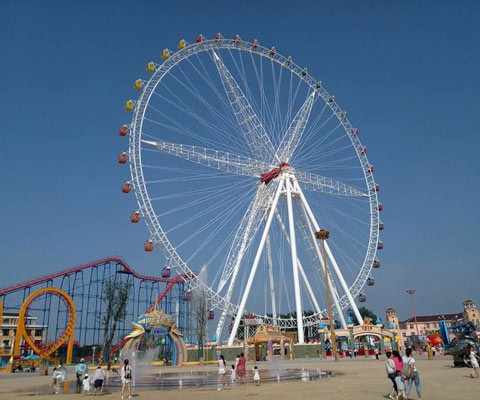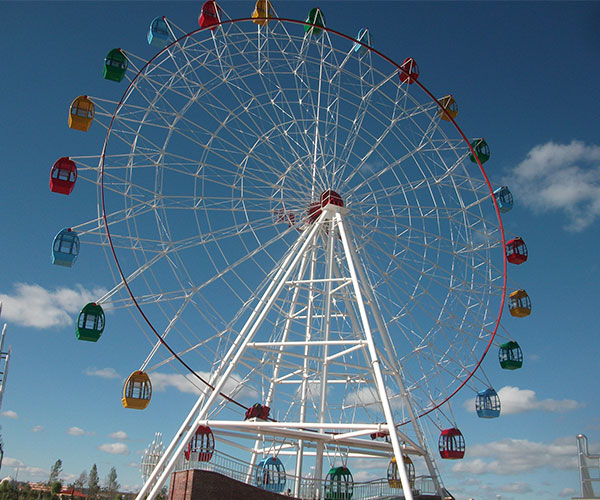The Ferris wheel, an iconic feature of amusement parks and city skylines, operates on a relatively simple yet ingenious principle. Its design relies on the combination of gravitational and centripetal forces to provide a thrilling yet safe ride experience. Let’s delve into the working principle of the Ferris wheel.
Structure and Components
Support Structure: The Ferris wheel made by professional ferris wheel manufacturers consists of a large vertical rotating wheel supported by a central axle. This axle is anchored securely to the ground or a stable foundation. The wheel is typically constructed of steel or other sturdy materials to ensure structural integrity.

Passenger Gondolas
Attached to the outer rim of the wheel are passenger gondolas or cabins. These cabins are where riders sit or stand during the ride. They are designed to be safe and comfortable, often featuring seats, safety restraints, and sometimes even amenities such as air conditioning or glass floors for enhanced views.
Drive System
To rotate the wheel, a drive system is employed. This system may consist of electric motors, gears, and other mechanical components to provide the necessary torque and rotational force.
Working Principle
Start-Up: When the Ferris wheel is activated, the drive system begins to rotate the wheel slowly. As the wheel gains momentum, passengers waiting in line board the gondolas. The wheel, as one of the most popular theme park rides for sale, typically continues to rotate at a constant speed throughout the ride, ensuring a smooth experience for riders.

Gravitational Force
The primary force at play in the Ferris wheel’s operation is gravity. As the wheel rotates, each gondola experiences changes in its position relative to the ground. When a gondola reaches the highest point of the wheel’s rotation, it is subjected to the maximum gravitational force pulling it downward toward the center of the Earth. Conversely, when the gondola descends to the lowest point, the gravitational force is still present but is partially offset by the centrifugal force.
Centripetal Force
In addition to gravitational force, the Ferris wheel relies on centripetal force to keep the cabins moving in a circular path. Centripetal force is the inward force acting on an object moving in a circular path, and it is essential for maintaining the gondolas’ trajectory around the wheel. This force is generated by the wheel’s rotation and the structure’s design, ensuring that the cabins remain securely attached to the rim and do not fly off as they ascend and descend.
Equilibrium
At each point in the Ferris wheel’s rotation, the forces acting on the gondolas achieve equilibrium, meaning that the gravitational force pulling downward is balanced by the centripetal force pulling inward. This equilibrium ensures that the gondolas remain stable and passengers experience a smooth ride without feeling excessive acceleration or deceleration.
Safety Features
Ferris wheels are designed with numerous safety features to protect riders. These may include redundant mechanical systems, emergency brakes, and regular inspections to ensure structural integrity. Additionally, modern Ferris wheels often incorporate advanced monitoring and control systems to detect any anomalies and ensure safe operation.
In conclusion, the Ferris wheel operates on a straightforward yet effective principle that combines gravitational and centripetal forces to provide an enjoyable and safe ride experience. As one of the most beloved attractions in amusement parks and cityscapes worldwide, the Ferris wheel, made by Beston Amusement Rides, continues to captivate riders of all ages with its timeless appeal and mesmerizing views.
